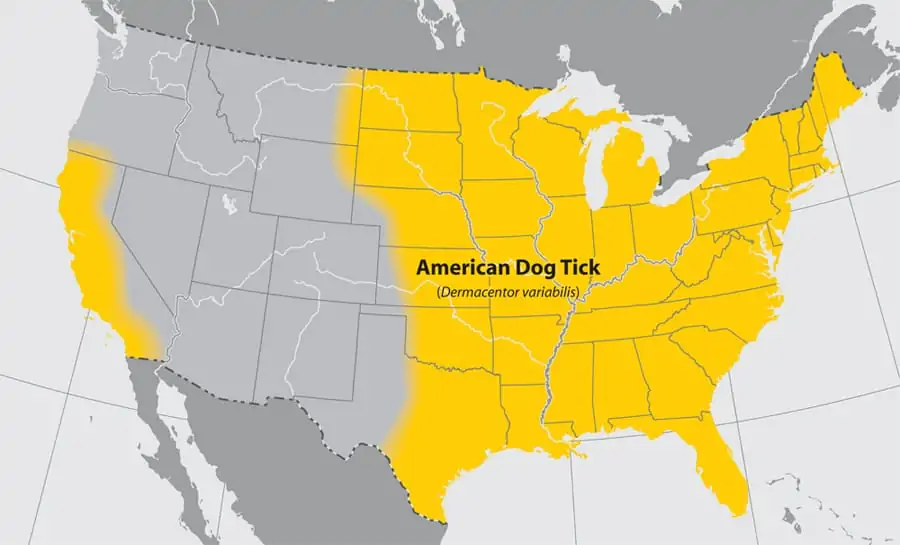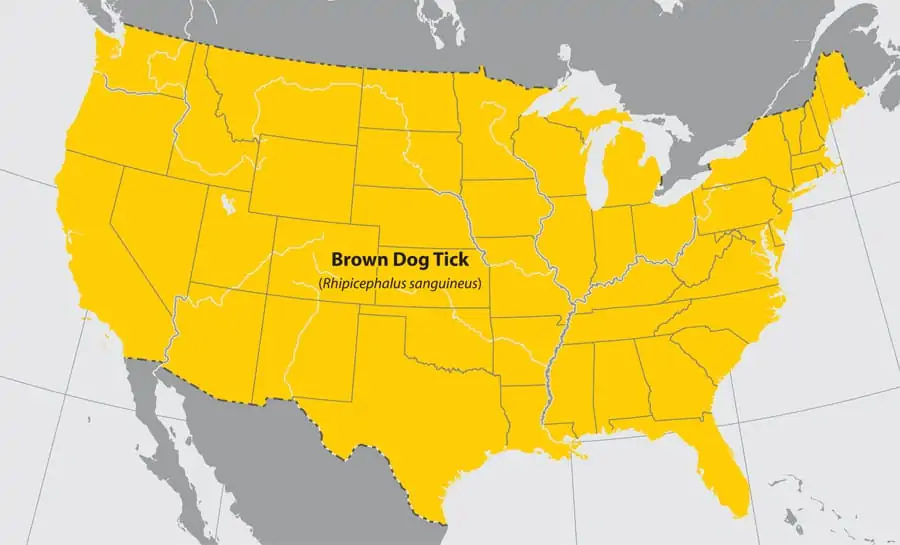
Ticks on dogs are already one of the most common concerns amongst pet parents. This year, they’re about to get even worse! Experts believe that due to the mild winter experienced in many parts of the United States, ticks are going to be at a significantly above-average threat level for the foreseeable future.
I had the unfortunate experience of witnessing this first-hand recently. To my knowledge, my dog has only ever had one tick on him before last week. As an excuse to get out of the house, we went to a local park where I thought I was being smart and avoiding ticks by sticking to a paved trail. From one short walk he managed to pick up 6 ticks and the rest of my day was spent scouring both of our bodies, washing clothes, and vacuuming my car to make sure no stragglers remained.
I honestly feel lucky compared to some of the stories I’ve heard of dogs coming back with dozens of ticks, some even with hundreds, from one walk! Not only that, but I was prepared with my dog already taking Nexgard regularly and having him enrolled in pet insurance. When it comes to ticks, prevention is the best defense! To help you be ready, here are 10 common myths about ticks that all pet parents should stop believing. If you know the reality behind these, you’ll be well on your way to winning the war we pet parents constantly wage against ticks!
1. Ticks on dogs are only a problem when hiking or camping.
We tend to only think about ticks when we’re spending extended time in the outdoors doing activities such as camping or hiking. The fact is that ticks can be found anywhere there is vegetation on the ground. This is especially true during times like this year when tick activity is abnormally high.
Even if you don’t live in a heavily-wooded area, you still need to take precautions every time your dog is outside. Lots of dogs pick up ticks just from being in their own back yard! Doing a quick spot-check before your dog comes back into the house is ideal, but there are also preemptive measures you can take to make sure your yard isn’t a safe-haven for these pests.
The most important thing to do is keep your grass cut short. Use a weed whacker to trim areas where a lawn mower can’t reach such as against fences, sheds, and other structures. Having a three-foot barrier of wood chips or gravel between your lawn and any wooded areas on your property can also help keep ticks at bay.
The second part of keeping ticks off your property is keeping out the wild animals who carry them. Deer, raccoons, groundhogs, and mice are all capable of carrying ticks and spreading them to wherever they visit. Keeping your trash secured in cans with lids and, for even more protection, installing a fence will help keep out the majority of unwanted animals. As an added bonus, having a fenced backyard allows you the opportunity to install a doggy door!
2. Ticks on dogs are only a problem in the spring and summer.
Contrary to popular belief, ticks are a year-round pest. Any time the temperature is above freezing, ticks are active and eager to feed. Ticks will be even happier if you or your dog bring them inside the house where it was warm and toasty! Do not stop giving a tick-control product to your dog just because it’s fall or winter.
3. Ticks on dogs are easy to spot.
Ticks are very small—they can be as small as the size of a pin head! The fact is that ticks on dogs are incredibly hard to locate, especially if your pup has longer fur. If you are able to spot them easily because they are larger in size, it probably means they’ve already been feeding for awhile on your dog and are full of blood.
This is one of the reasons that using a tick-control product such as Nexgard or Frontline Plus is incredibly important. They quickly and effectively kill the ticks that bite your dog. This prevents them from continuing to bite, spread, and reproduce further.
4. Only deer ticks on dogs are dangerous.
Especially in the northeastern United States, deer ticks are the most well-known type of tick due to their likelihood of carrying Lyme disease. That doesn’t mean that deer ticks are the only type of tick to worry about. Here are some of the varieties of tick to be aware of, where they are found in the United States, and a sampling of some of the potential risks they pose.
Type: American Dog Tick Location: Eastern Half of the US & California Potential Risks: Tularemia, Rocky Mountain Spotted Fever

Type: Blacklegged Tick (Deer Tick) Location: Eastern Half of the US Potential Risks: Lyme Disease, Relapsing Fever, Various Others

Type: Brown Dog Tick Location: All of the US Potential Risks: Rocky Mountain Spotted Fever

Type: Gulf Coast Tick Location: Southeastern Coast and Gulf Coast of the US Potential Risks: Spotted Fever

Type: Lone Star Tick Location: Eastern Half of the US Potential Risks: Spotted Fever

Type: Rocky Mountain Wood Tick Location: Higher Elevation Areas of the Northwestern US Potential Risks: Rocky Mountain Spotted Fever, Colorado Tick Fever, Tularemia

Type: Western Blacklegged Tick Location: Western Coast of the US Potential Risks: Lyme Disease

As you can clearly tell, deer ticks are not the only culprit of spreading diseases and just because you live outside of the northeastern region of the United States doesn’t mean your dog is safe from ticks.
Tick-borne illnesses can not only be dangerous to your dog but can also result in extremely costly veterinary visits. That’s why we recommend all responsible dog owners get a free, online pet insurance quote from Healthy Paws. They cover up to 90% of your dog’s medical expenses and provide you with peace of mind knowing you will always be able to afford the best care possible for your furry family member.
Related: Veterinarians Weigh In: Should You Get Pet Insurance?
5. If your dog is vaccinated against Lyme disease, they don’t need to use a tick-control product.
After reading the first four myths, you hopefully realize that ticks are capable of spreading much more than just Lyme disease. Just because your dog is vaccinated for Lyme disease doesn’t mean that they are safe from the host of other diseases that ticks could be carrying.
Secondly, you don’t want your dog harboring ticks that they could spread to other dogs, humans, or pets. Ticks are pests whether or not they are carrying diseases and your dog should be protected against them to the best degree possible.
I prefer using an oral tick-control product like Nexgard. You give it once a month with your dog’s dinner and that’s it. No mess and no worry about it washing off. My dog actually loves it and thinks it’s a treat! Other pet parents prefer a topical solution like Frontline Plus. This has its advantages as well like helping to prevent ticks from attaching in the first place, but mostly it comes down to personal preference. No matter which type of tick-control product you use, make sure you use something!
6. Ticks transmit diseases as soon as they bite.
It almost always takes a minimum of 3 hours of being attached for ticks to transmit bacteria. This timeframe can sometimes be over 24 hours. This speaks to why it’s so important to always check your dog from ticks after being outside and immediately remove them.
It also shows why tick-control products are so important to help kill any ticks you may have missed when checking your dog. No matter if you use a topical or oral solution, these tick-control products kill ticks on dogs after they attach. While they’re not always perfect, the goal of these products is to kill the ticks before they are able to transmit the bacteria that causes diseases.
7. Using “home remedies” are better for the removal of ticks on dogs than tweezers.
There are countless home remedies of how to remove ticks from your dog. Burning them, freezing them, and using fingernail polish are just a few of these myths. None of these home remedies are more effective or safer than using a pair of tweezers to gently detach the tick from your dog’s skin. In fact, many of these home remedies could easily injure or cause a lot more stress to your dog than they’re already in.
How to Remove Ticks on Dogs:
Removing an attached tick with tweezers is actually very simple. While avoiding the abdomen, grasp the tick as close to your dog’s skin as possible. Gently and steadily pull the tick straight out until it is detached. Do not jerk or twist as this could cause the tick’s head to break off from the abdomen. Once removed, simply clean the area with soap and water and clean the tweezers with rubbing alcohol.
8. If you attempt to remove a tick and its head breaks off in the skin, it can still transmit diseases.
This might be the most common myth out of all of them. I believed this myth myself for the longest time! It’s also why people tend to opt for those silly home remedies to remove ticks—it’s a lot of pressure having to remove a tick so precisely with tweezers that you avoid the head detaching from the body.
The good news is that this pressure isn’t backed by science! While your goal should be to remove the entire tick with the head still intact, if you accidentally leave the head in your dog’s skin it’s not the end of the world. It may cause some minor irritation around the area, but it will fall out on its own. To help soothe the area and speed up the process, you can apply a warm, wet compress to the affected area.
9. Your dog will show symptoms of tick-borne illnesses within the first few days.
You may think you’re in the clear if your dog has been symptom-free for a few days after finding a tick attached to them. Unfortunately, you’re not out of the woods so quickly. Symptoms of tick-borne diseases in dogs may not present themselves for a month or more after being bitten!
Symptoms can vary depending on the disease transmitted, but common ones include fever, weakness/fatigue, swelling, loss of appetite, and vomiting. If you notice these in your dog, especially after them having been bitten by a tick, please contact your local veterinarian immediately.
Tick-borne illnesses can not only be dangerous to your dog but can also result in extremely costly veterinary visits. That’s why we recommend all responsible dog owners get a free, online pet insurance quote from Healthy Paws. They cover up to 90% of your dog’s medical expenses and provide you with peace of mind knowing you will always be able to afford the best care possible for your furry family member.
Related: Is Pet Insurance a Waste of Money?
Remember when removing a tick from your dog to save it just in case. In case your dog shows symptoms of a tick-borne illness, having the dead tick can allow your veterinarian to test it. Put the tick either in a zip-lock bag or tape it to an index card. Then put it in the freezer to kill and store it. Make note of the date as well as the place it was likely picked up from.
10. You can contract tick-borne illnesses from your dog.
We humans can’t contract tick-borne illnesses from dogs. However, that doesn’t mean we don’t have to worry. Our dogs can still bring ticks into our homes where they now have the potential to bite us. As such, the more we protect our dogs from ticks, the more we protect our entire families as well.









